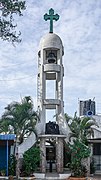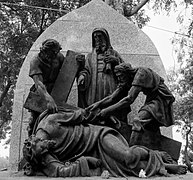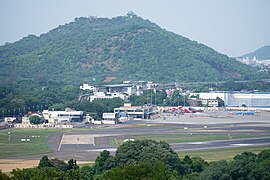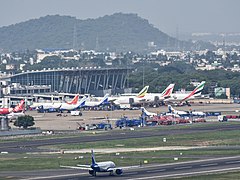world.wikisort.org - India
Parangimalai (known in English as St. Thomas Mount) is a small hillock in Chennai, Tamil Nadu, India, near the neighbourhood of Guindy and very close to Chennai International Airport.
Parangimalai
பரங்கிமலை St. Thomas Mount | |
|---|---|
Hillock | |
 St Thomas Church on the Mount | |
 Parangimalai 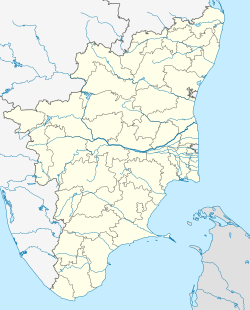 Parangimalai | |
| Coordinates: 13°0′18.2″N 80°11′35.9″E | |
| Country | India |
| State | Tamil Nadu |
| Metro | Chennai |
| Government | |
| • Body | St.Thomas Mount-cum-Pallavaram |
| Elevation | 91.44 m (300.00 ft) |
| Languages | |
| • Official | Tamil |
| Time zone | UTC+5:30 (IST) |
| Planning agency | CMDA |
The ancient Syrian Christian community of India trace the origin of their church to St. Thomas the Apostle. From the 17th century, this part of Chennai was populated predominantly by Anglo-Indians. The St. Thomas Garrison Church is at the foot of St. Thomas Mount.
The St. Thomas Syro Malabar Catholic Church is located east of the shrine at North Silver Street, footholds of the mountain shrine.
The neighbourhood is served by the St. Thomas Mount railway station, on the southern line of the Chennai Suburban Railway Network.[citation needed] Integration of the Metro and MRTS with the suburban station in the neighbourhood, is expected to make the suburb the city's largest transit hub after Chennai Central.[1]
In the state assembly elections of 1967 and 1971, there was a constituency known as the Parangimalai.
Etymology
According to tradition, Sage Bhringi resided and meditated on the hillock in his quest to see Lord Shiva. The locality thus came to be known as Bhringi malai, or "the hill of Bhringi", which over time morphed as "Parangimalai". It is also said that this connects several other regions in the city with the origin of their names. For instance, the place where he laid his pitcher, known in Tamil as kindi while performing worship, has now come to be known as "Guindy".[2]
The place is named St. Thomas Mount in English in honour of Saint Thomas the Apostle, who lived and preached in the locality[2]
Hill shrine
A shrine dedicated to "Our Lady of Expectation" (Mother Mary) was built in 1523 on top of the Mount. The altar of this shrine was built on the spot where St. Thomas' death is traditionally believed to have been occurred. At the northern foot of the mount, is a gateway of four impressive arches surmounted by a cross bearing the inscribed date 1547. A flight of 160 steps leads up to the summit of the mount. There are 14 stations of the cross on the way to the summit.
Educational institutions
St. Thomas Mount has several schools and training institutions.
Schools

- St Dominic's Anglo-Indian Higher Secondary School was founded in July 1901 Holy Apostles Convent European School for children of the British and Anglo Indian Army Personnel. In 1914 it was renamed as St Dominic's School. In 1978 Class 12 was added.[3]
- Marian Matriculation Higher Secondary School is an English medium, co-educational senior secondary school from lower kindergarten (LKG) to class 12.[4][5]
- St. Thomas Academy is an English medium, co-educational higher secondary school started in July 2017 and by 2022 had about 400 students. It is affiliated with the Central Board of Secondary Education (CBSE).[6][7]
Vocational training institutes
- St Theresa of Child Jesus School of Nursing is located in St. Thomas Hospital. Started in 1993, by 2012 it was admitting 20 students annually.[8][9]
- Montfort Technical Institute is a private industrial training institute (ITI). Established in Jan 1972, it is one of 326 private ITIs in the state of Tamil Nadu.[10][11][12]
Governance
The St. Thomas Mount block is a revenue block in the Chengalpattu district of Tamil Nadu, India.[13] As per the Census 2011, the St. Thomas Mount development block covered an area of 86.94 km2 (33.57 sq mi), of which 42.98 km2 (16.59 sq mi) was classified as rural and 43.96 km2 (16.97 sq mi) as urban. The block included 121,017 household with a total population of 475,995. The sex ratio was 978.7 females per 1,000 males. The number of children in the age group 0-6 years was 55,103. Scheduled castes numbered 74,322 (15.6%) and scheduled tribes were 2.544 (0.53%). The literacy rate was 77.6%, with males at 81.3% and females at 73.9%.[14]
The following 15 rural village panchayats come under St Thomas Mount Panchayat Union:[13]
- Agaramthen
- Medavakkam
- Kovilambakkam
- Cowl bazaar
- Mudichur
- Perumbakkam
- Nanmangalam
- Polichalur
- Trisulam
- Ottyambakkam
- Thiruvanchery
- Vengaivasal
- Madurapakkam
- Moovarasampattu
- Sithalapakkam
Gallery
Exterior of the Church
- Entrance to the Shrine
- Main entrance to the Church
- Bell tower
- Blessed Sacrament Adoration Chapel
- Mary Untier of Knots
- Flagstaff
- Mother Teresa
Interior of the Church
- Nave
- Altar
- Relic of an Apostle
- St. Thomas & Infant Jesus
- Gravestone in the entrance
Stations of the Cross
The 14 Stations of the Cross are positioned along the 160-step climb up the Mount.
- 3: Jesus falls for the 1st time
- 5: Simon helps carry the Cross
- 10: Jesus is stripped of his garments
- 13: Jesus is taken down from the Cross
- 14: Jesus is laid in the tomb
Views from the Mount

- View to north-west
- Alandur Metro Station
- AirAsia A320 final approach
- NE runway, Pallavaram Hill
- Indigo A320 touch down
- International terminal
References
- Ayyappan, V (28 January 2013). "From Tonga Stop to Transport Hub". The Times of India. Chennai: The Times Group. Retrieved 3 February 2013.
- Krupa, Lakshmi (22 August 2013). "What's in a name?". The Hindu. Chennai: Kasturi & Sons. Retrieved 8 August 2022.
- "ABOUT ST.DOMINICS". St. Dominic's Anglo-Indian School. 2020. Retrieved 31 August 2022.
- "Marian Matriculation Higher Secondary School, St. Thomas Mount". UrbanPro. Retrieved 31 August 2022.
- "Marian Matriculation Higher Secondary School". Facebook. Retrieved 31 August 2022.
- "Our History". St. Thomas Academy. 2022. Retrieved 31 August 2022.
- "Details OF SCHOOL AFFILIATED TO Central Board of Secondary Education". Central Board of Secondary Education. Retrieved 31 August 2022.
- "Milestones". St. Thomas Hospital, Chennai. 2012. Retrieved 31 August 2022.
- "Nursing School". St. Thomas Hospital, Chennai. 2012. Retrieved 31 August 2022.
- "Montfort Private Technical Institute". ITI Directory. 7 July 2022. Retrieved 31 August 2022.
- Directorate of Employment and Training (DET). "Welcome to Industrial Skill Training". Department of Labour and Employment (Tamil Nadu).
- Directorate of Employment and Training (DET). "Name of the Private Industrial Training Institute in Tamil Nadu" (PDF). Department of Labour and Employment (Tamil Nadu).
- "Local Body Ward Delimitation – 2020 – Chengalpattu District | Kancheepuram District,Government of Tamilnadu | City of Thousand Temples | India". Retrieved 6 March 2020.
- Census of India 2011: District Census Handbook Kancheepuram Tamil Nadu Village and Town Wise Primary Census Abstract (PCA). Part XII-B, Series 34. Directorate of Census Operations, Tamil Nadu. 2014. pp. 28–29. Retrieved 31 August 2022.
External links
На других языках
[de] St. Thomas Mount
Der St. Thomas Mount (Tamil: புனித தோமையர் மலை; auch Parangimalai, Tamil: பரங்கிமலை) ist eine Anhöhe im gleichnamigen Vorort von Chennai (Madras), der Hauptstadt des südindischen Bundesstaates Tamil Nadu. Er verdankt seinen Namen dem christlichen Apostel Thomas, der angeblich hier den Märtyrertod erlitten haben soll. Der 67 Meter hohe St. Thomas Mount befindet sich im Süden der Stadt nahe dem Flughafen Chennai.- [en] Parangimalai
[fr] Mont Saint-Thomas
Le mont Saint-Thomas (en tamoul : பரங்கி ; en anglais : St. Thomas Mount) est une colline rocheuse de 91 mètres de haut se trouvant dans le taluk Pallavaram situé dans la banlieue sud-ouest de la ville de Chennai en Inde. Étant le lieu présumé du martyre et de la mort de l’apôtre saint Thomas elle est devenue un lieu de pèlerinage assidument fréquenté par les chrétiens de l’Inde. Une petite église construite au XVIe siècle abrite une croix de Saint-Thomas, sculptée dans la pierre noire, qui date du VIe ou VIIe siècle.Другой контент может иметь иную лицензию. Перед использованием материалов сайта WikiSort.org внимательно изучите правила лицензирования конкретных элементов наполнения сайта.
WikiSort.org - проект по пересортировке и дополнению контента Википедии


